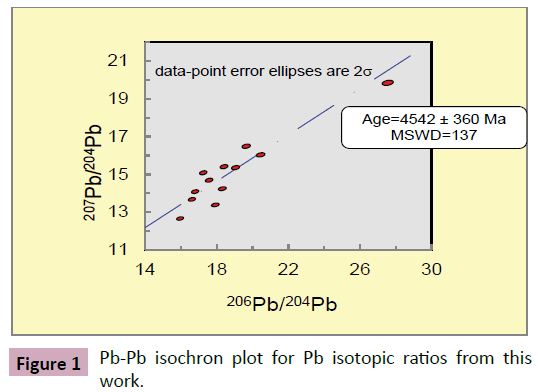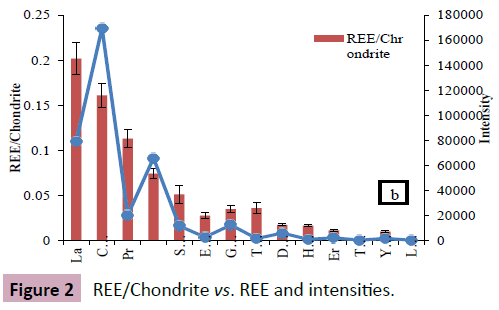Manny Mathuthu* and Ntokozo Khumalo
Center for Applied Radiation Science and Technology (CARST), North-West University, South Africa
Corresponding Author:
Manny Mathuthu
Professor of Radiation Science, CARST
North-West University, South Africa.
Tel: +27 76 507 3327
E-mail: mathuthu@gmail.com; Manny.Mathuthu@nwu.ac.za
Received date: March 14, 2016; Accepted date: April 19, 2016; Published date: April 22, 2016
Citation: Mathuthu M, Khumalo N. Developing Nuclear Forensics Signatures and National Nuclear Forensics Libraries for the African Continent: A Case Review for South Africa. Int J Appl Sci Res Rev. 2017, 4:1. doi: 10.21767/2349-7238.100052
Copyright: © 2016 Mathuthu M, et al. This is an open-access article distributed under the terms of the Creative Commons Attribution License, which permits unrestricted use, distribution, and reproduction in any medium, provided the original author and source are credited.
Keywords
Uranium products; Nuclear terrorism; Nuclear forensics signatures; Nuclear forensics libraries; ICP-MS; LA-ICP-MS; Gamma spectrometry
Introduction
Many countries in Africa have resources such as gold, uranium, coal and gas, not to mention the agricultural land. While most of these countries are capable of utilizing these resources to the benefit of their citizens, it is not so with uranium deposits. Most African countries export the uranium for further processing into fuel for the nuclear reactor. Namibia has (42 uranium Mines), Nigeria (2), Egypt (5), Algeria (6), Chad (1), Botswana (9), Cameroon (2), DRC (9), Malawi (3), Central African Republic (5), Tunisia (1), Senegal (10), Zambia (10), Tanzania (10), South Africa (71) and Zimbabwe (1) [1]. All these countries have to observe the Non-Proliferation Treaty [2,3] which aims at safeguarding nuclear material and prevent nuclear terrorism due to illicit trafficking of the material. South Africa has around 71 uranium mines mainly located on the Witwatersrand Supergroup [4] (Figure 1) where a lot of gold/uranium mining has been going on for over 130 years [5]. Before September 1991 South Africa was capable of processing and enriching its own uranium [6,7] and she was making nuclear bombs [6,8]. She was forced to stop her nuclear programme in 1991 and all the nuclear materials stoke pile needs accounting and control. This need arose due to rising nuclear security concerns about the safety and proliferation of the nuclear materials [9,10] and possible diversion for illicit purposes by nuclear terrorists [11,12]. Each nation should have a National Nuclear Programme aimed at characterization of seized nuclear or radioactive material to determine its chemical and isotopic composition and physical parameters which form signatures of the origin of the interdicted radiological nuclear material. Such a database is lacking in all the African countries. No African country has a developed nuclear forensics library and South Africa is only starting, but does not yet have a fully functional nuclear forensics laboratory.

Figure 1: Pb-Pb isochron plot for Pb isotopic ratios from this work.
The aim of this Research Review is to highlight some of the techniques that have been used for developing nuclear forensics libraries and it is hoped that African nations can apply some of these techniques in developing their NNFL from the nuclear forensics signatures as required by the IAEA for each Member Sate [3]. In this work we then present some results that have been done from a uranium mine in Carletonville South Africa as an example.
The case of South Africa
There is therefore a need for South Africa and all the African countries to develop nuclear Forensic signatures and NNFL for their nuclear stoke pile (uranium mines, uranium material, yellow cake (U3O8), Nuclear Reactor fuel and spent fuel).
A nuclear forensics Library of all nuclear material in South Africa is vital for identifying and retribution of any interdicted nuclear material from any African country. South Africa is the most likely route for nuclear material trafficking due to its vast transport network.
The Nuclear Forensic Laboratory (NFL)
Using South Africa as an example again, there should be a Nuclear Forensics Laboratory setup with full instrumentation, National Institute of Standards and Technology (NIST) calibration standards and Nuclear Scientists (some of whom can be trained at the Center for Applied Radiation Science and Technology (CARST), North-West University (Mafikeng). The first samples analyzed in such a Laboratory are the uranium ore samples from the national mines. Each country (e.g., Zimbabwe and Namibia) can start at this front end of the Nuclear Fuel Cycle (NFC). For South Africa and Namibia which can process the ore into uranium metal and further into yellow cake, the NFL can analyze such samples to build a data base of signatures at different stages of the NFC.
Forensic signatures
Nuclear forensic signatures can be obtained from the following categories of data:
Rare Earth Elements (REE) of the periodic table as these exhibit consistent patterns under varying geochemical conditions [13,14]. This becomes a signature (or reflection) of the geochemical conditions of the mine.
Trace element compositions show the impurities for each uranium processing [15].
The U-Pb isotope composition [15,16].
Concordia age dating of the samples [17,18].
Some of the Instruments used for geo-chronometric analysis of intercepted nuclear materials from a nuclear facility include: the LA ICP-MS or laser-ablation micro-sampling (LAM-ICP- MS), ICPMS [14,19-21], as well as Gamma Spectrometry [22].
Materials and Methods
Study area
Geology of the mining site
The Witwatersrand Supergroup in South Africa has one of the largest gold and uranium deposits in the world. Although many studies have researched onto the mineralogy, geochemistry and chronology of this Reef [4,14,15,23], few studies have looked at the developing nuclear forensics signatures for the 72 uranium mines. The sampling site falls within the Carletonville goldfield which is part of the so called B-Reef or Witwatersrand Supergroup. The uraninite (UO2x) deposits [24], here are unconformity in nature lying on the sedimentary succession of the Witwatersrand Supergroup, with an estimated age of about 2.59 Ga [4]. Gold (and uranium) mining uses the underground mining techniques as the mines are each estimated to be more than 2 Km deep. A full description of the different type’s uranium deposits in this area and the mechanisms thereof is given by Fuchs [4].
The study area, sample collection, preparation and analysis on the Inductively Coupled Plasma Mass Spectrometer (ICP-MS), and by gamma spectrometry is described in our other articles [25,26] and the authors cannot give further details due to confidentiality agreements.
Results for Carletonville REE Patterns and U-Pb Isotopic Ratio
REE signatures
In Figure 2, the intensities of the REE/C1-Chondrite normalized decrease with the ascending order of atomic number for both tailing dams. Studies conducted by Asai and Limbeck [13], reported a directly proportional relationship between REE atomic number and intensity or integrated counts which is opposite of this work. This can be due to additional interferences or elemental fractionation from the ICP-MS. The result of our study is dominated by LREE, which gives a signature for this mine. There is enrichment in the LREE and a depletion of the HREE for this mine [15].

Figure 2: REE/Chondrite vs. REE and intensities.
Conclusion
The results presented here demonstrate that South Africa and all other African countries have the capability to develop their own nuclear forensic signatures to account for nuclear materials [27,28].
Acknowledgements
Authors would like to acknowledge the International Atomic Energy Agency (IAEA) for sponsoring this Project under CRP J2003, (IAEA Research Contract No.: 18777). We also acknowledge the assistance provided by Lebo Motsei and Tseole Mpho on the isotopic ratio technique.
References
- IAEA (2016) "Integrated nuclear fuel cycle information systems”.
- USA Department of State (1970) "Treaty on the non-proliferation of nuclear weapons," U.D.O. State, Washington DC, USA: USA Department of State, pp: 1-15.
- IAEA N (2015) "Activities of the international atomic energy agency relevant to article iii of the treaty on the non-proliferation of nuclear weapons," in 2015 review conference of the parties to the treaty on the non-proliferation of nuclear weapons, pp: 1-19.
- Fuchs S, Williams-Jones AE, Przybylowicz WJ (2016) The origin of the gold and uranium ores of the black reef
formation, transvaal Supergroup, South Africa. Ore Geol Rev 72: 149-164.
- SAHO (2016) Colonial history and development of Johannesburg.
- Albright D (1994) South Africa's secret nuclear weapons. Institute for Science and International Security.
- Horton III RE (1999) Out of (South) Africa: pretoria's weapons experience. USAF Academy, Colorado Springs, Colo, Institute for National Security Studies, U.S. Air Force Academy, pp: 38-41.
- Schmelzer FE (2003) South Africa nuclear case closed. DOS. USA, Edn: Department of State USA, pp: 1-2.
- Molgaard JJ, Auxier JD, Giminaro AV, Oldham CJ, Cook MT, et al. (2015) Development of synthetic nuclear melt glass for forensic analysis. J Radioanal Nucl Chem 304: 1293-1301.
- Varga Z (2008) Application of laser ablation inductively coupled plasma mass spectrometry for the isotopic analysis of single uranium particles. Analytica Chimica Acta 625: 1-7.
- Hutcheon ID, Kristo MJ, Knight KB (2015) Nonproliferation nuclear forensics end: Glenn Seaborg Institute,
Lawrence Livermore National Laboratory, USA.
- Kristo MJ (2011) "Chapter 21-Nuclear Forensics," In: L'Annunziata MF (ed.) Handbook of Radioactivity Analysis (3rd edn.), Amsterdam: Academic Press, pp: 1281-1304.
- Asai S, Limbeck A (2015) "LA-ICP-MS of rare earth elements concentrated in cation-exchange resin particles for origin attribution of uranium ore concentrate". Talanta 135: 41-49.
- Pourmand A, Dauphas N, Ireland TJ (2012) A novel extraction chromatography and MC-ICP-MS technique for
rapid analysis of REE, Sc and Y: Revising CI-chondrite and Post-Archean Australian Shale abundances. Chem Geoly 291: 38-54.
- BartonDK (1996) Trace-element and U-Pb isotope compositions of pyrite types in the Proterozoic Black Reef, Transvaal Sequence, South Africa: Implications on genesis and age. Chem Geol 133: 173-199.
- Fahey AJ, Rictchie NWM, Newbury DE, Small JA (2010) The use of lead isotopic abundances in trace uranium samples for nuclear forensics analysis. J Radioann Nucl Chem 284: 575-581.
- Andersen T, Grorud HF (1998) Age and lead isotope systematics of uranium-enriched cobalt mineralization in the modum complex, south norway implications for precambrian crustal evolution in the SW part of the Baltic Shield. Precambrian Res 91: 419-432.
- Dickinson WR, Gehrels GE (2009) Use of U-Pb ages of detrital zircons to infer maximum depositional ages of strata: A test against a Colorado Plateau Mesozoic database. Earth Planet Sci Lett 288: 115-125.
- Varga Z, Katona R, Stefanka Z, Wallenius M, Mayer K, et al. (2010) Determination of rare-earth elements in uranium bearing materails by binductively coupled plasma mass spectrometry. Talanta 80: 1744-1749.
- Balcaen L, Moens L, Vanhaecke F (2010) Determination of isotope ratios of metals (and metalloids) by means of inductively coupled plasma-mass spectrometry for provenancing purpose-A review. Spectrochim Acta B 65: 769-786.
- Andersen T (2002) Correction of common lead in U–Pb analyses that do not report 204Pb. Chemical Geology 192: 59-79.
- Norman EB (2016) "Nuclear forensics using gamma-ray spectroscopy”. Nuclear 123: 4.
- Schoene B (2014) U-Th-Pb Geochronology, in treatise on geochemistry (2nd edn.). Princeton University,
Princeton, NJ, USA, pp: 341-378.
- Balboni E, Nina J, Spano T, Simonetti A, Burns PC (2016) Chemical and Sr isotopic characterization of North America uranium ores: Nuclear forensic applications. Appl Geochem 74: 24-32.
- Mathuthu M, Kamunda C, Madhuku M (2016) Modelling of radiological health risks from gold mine tailings in wonderfonteinspruit catchment area, South Africa. Int J Environ Res Public Health 13: 1-11.
- Kamunda C, Mathuthu M, Madhuku M (2016) Health risk assessment of heavy metals in soils from witwatersrand gold mining basin, South Africa. Int J Environ Res Public Health 13: pii: E663.
- Svedkauskaite-LeGore J, Mayer K, Millet S, Baltrunas D (2007) Investigation of the isotopic composition of lead and of trace elements concentrations in natural uranium materials as a signature in nuclear forensics. Radiochim Acta 95: 601-605.
- Ludwig KR (1998) On the treatment of concordant Uranium-Lead ages. Geochim Cosmochim Acta 62: 665-676.



